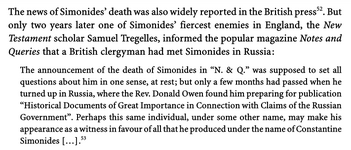Yes, it does seem to have been placed as a footnote on a manuscript that is in Halki (Antigonus).
Here's how this quote makes it's way to us.
From Avery

From Farmakidis

From Simonides
 Simon sez
Simon sez Alexander Sturdza says
 Simon sez
Simon sez Kapodistras writes
Here's the Greek text of Farmakidis, who omitted telling you that it's a direct quote from...you guessed it!
Simon sez...
A Simonides book!
ΝΙΚΟΛΑΟΥ
ΤΟΥ ΑΓΙΩΤΑΤΟΥ ΕΠΙΣΚΟΠΟΥ
ΜΕΘΩΝΗΣ
ΛΟΓΟΣ ΠΡΟΣ ΤΟΥΣ ΛΑΤΙΝΟΥΣ
ΠΕΡΙ
ΤΟΥ ΑΓΙΟΥ ΠΝΕΥΜΑΤΟΣ
ΟΤΙ ΕΚ ΤΟΥ
ΠΑΤΡΟΣ ΟΥ ΜΗΝ ΚΑΙ ΕΚ ΤΟΥ ΥΙΟΥ
ΕΚΠΟΡΕΥΕΤΑΙ.
ΠΡΩΤΟΝ ΗΔΗ ΕΚΔΙΔΟΜΕΝΟΣ ΥΠΟ
ΚΩΝΣΤΑΝΤΙΝΟΥ ΣΙΜΩΝΙΔΟΥ
ΔΙΔΑΚΤΟΡΟΣ ΤΗΣ ΦΙΛΟΣΟΦΙΑΣ.
Page 115
Footnote 1
Ἐν Οδησσῷ εὑρισκόμενος, καὶ ὑπὸ τὴν κηδεμονείαν τοῦ ἀοιδίμου Αλεξάνδρου Στούρτζα τοῦ κλεινοῦ ἐκείνου διατελῶν, καὶ λόγου γενομένου περὶ Βενεδίκτου, ἤκουσα αὐτοῦ λέγοντος τάδε·
" Ἰωάννης ὁ Καποδιστρίας, ὁ θεῖος ἐκεῖνος ἀνὴρ, ἔγραψέ μοι πολλάκις ταῦτα..."
“Οὐδένα εὗρον ἐν Ἑλλάδι μέχρι τῆς ἡμέρας ταύτης παιδείαν ἔχοντα ἀληθῆ, πλὴν τοῦ γηραιοῦ Βενεδίκτου τοῦ Συμαίου, ᾧ μάλιστα καὶ τὴν ἄρτι συσταθεῖσαν ἐν Πόρῳ δογματικὴν σχολὴν ἐνεπιστευσάμην..."
Source link:
https://books.google.co.nz/books?printsec=frontcover&id=5_cCAAAAQAAJ#v=onepage&q&f=false
Avery Translation
This is
Procession of the Holy Ghost from the Father not the Son -
edited by Constantine Simonides
writing originally by Nicholas Methonis
[Personal Note Here: Notice Avery gives no details about date, page number, etc, or Simonides being the actual author of the publication, just a sheepish mention of "edited by"]
“Being in Odesa, and under the tutelage of the venerable Alexander Sturtzas, of that perpetual fame, and of the general account of Benedict, I heard this saying by Ioannes Kapodistrias, [of] the uncle of that young man, writing many of these..."There were no Europeans in Greece until that day who had a true education, except for the old Benedictus of Simaeus, who, indeed, founded a dogmatic school in Poros and entrusted me with it..."
My Rough Translation
OF NIKOLAOS
[HIS] HOLINESS THE BISHOP
OF METHONIS
[HIS] DISCOURSE TO THE LATINS
CONCERNING
THE HOLY SPIRIT
THAT IT PROCEEDS
FROM OUT OF THE FATHER,
[YET] NOT OUT OF SON ALSO
FIRST ALREADY ISSUED UNDER
KONSTANTINOS SIMONIDES
DOCTOR OF PHILOSOPHY.
London, 1859
Page 115
Footnote 1
"While I
[Simonides] found myself in Odessa, and under the custody of the famous Alexandros Stourtza, well known for his accomplishments, and when he happened to say a word
[Or: "happened to speak"] about Benedictos,
I [Simonides] heard him [Stourtza] say the following,
"John Kapodistrias, the uncle of that man [???], had many times written to me [Stourtza] these things,
"I [Kapodistras] could not discover a single person in Greece, up to that day, having a true education, except the old man Benedictos of Simaeus, by whom, in fact, the Arts were introduced, and in Poros a dogmatic school, with which I was entrusted..."
[Names and emphasis added by me]
Farmakidis trusts Simonides implicitly. He doesn't tell you where he actually sourced this quote from.
It is
Simon sez...
From a Simonides book from 1859.
Key phrase = ἤκουσα αὐτοῦ λέγοντος τάδε·
"I [Simonides] heard him say [the] following"
This entire quotation story here about what Stourtza and Kapodistrias supposedly said, rests solely on...
Simon sez ...
As the source.
Which was
my point.


